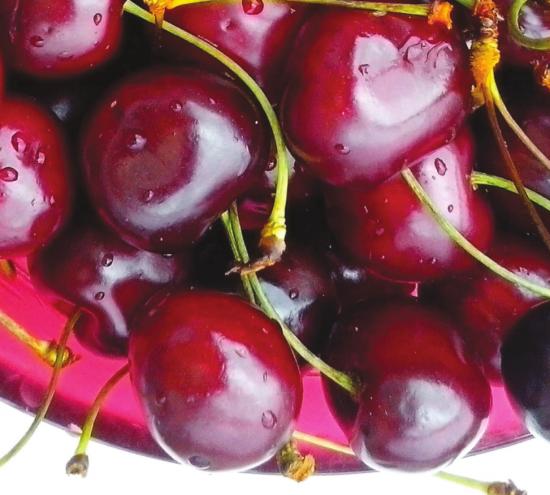The Worthy Cherry
July 1, 2016
 A Short History of Northern Michigan’s Favorite Fruit
A Short History of Northern Michigan’s Favorite Fruit After Detroit’s cars, the cherry is likely Michigan’s bestknown export. Michigan is the primary tart cherry-producing state, accounting for nearly 74 percent of the nation’s tart cherry production. The northern Michigan region has capitalized on its bounty, using the tiny jewel-red fruit to inspire a host of cherry products, from sodas, jams, ice creams and dried cherries to decor, artwork, and cherrythemed clothing and accessories. So where did the fervor for this fabulous fruit begin? Waaaay back.
DINOSAURS TO ROMANS
The cherry’s native range from prehistoric times was throughout Europe, northern Africa and Asia, and it has been collected as a foodstuff ever since. Cultivated varieties were grown in the Pontus region of Anatolia (today’s Turkey) in 72 B.C.; those varieties were reportedly brought to Rome by Roman republic politician Lucius Licinius Lucullus around 1 A.D. Much later, a variety of cherry was introduced to England by Henry VIII, after he’d tasted them in Flanders (Belgium). The cherry orchards in Kent, England are rumored to have been started by Henry VIII after he planted a cherry tree there in 1533. Cherry trees became widespread in northern Europe later in the century.
MIDWEST SETTLERS
As far as the cherry’s arrival in North America, it’s thought to have first shown up — as pits — in the 1600s, brought over on ships by early settlers who eventually brought them down the Saint Lawrence Seaway and into the Great Lakes area. French settlers often included cherry trees in their family gardens as they began to settle in Detroit and other parts of the Midwest; the sandy soil proved ideal for growing cherries, and the weather was temperate enough that crops were good. Soon, the cherry would find its way Up North.
UP NORTH ARRIVAL
The person credited with introducing cherry trees to the Traverse City area was a Presbyterian missionary named Peter Dougherty, from whose plantings the Traverse City cherry industry would grow decades later. Dougherty started planting cherry trees on the Old Mission Peninsula in 1852; the local Native Americans nicknamed him “Little Beaver” because, while he was a slight man, they could see that he was a very determined farmer. Once Dougherty’s neighbors saw that his cherry trees were actually growing and providing fruit, they began planting their own cherry trees. And so Michigan’s cherry boom began, prompting farmers to sell their surplus cherries elsewhere — an opportunity made possible as northern train links to Chicago and the rest of the country were built.
CHERRY LEGACY
As the little red fruit caught on around the nation, it inspired countless incarnations: ice cream sundaes and cocktails soon welcomed the Maraschino cherry. Gourmet desserts like Cherries Jubilee, cherry pie, cherry turnovers, cherry crisps, cherry candies and cherry cookies were standard dessert fare. More recently, cherries have made their way into everything from sausage, salsa, salad dressing, and chutney to beauty products and candles. For the cherry, life truly is … well, a bowl of cherries.
FUN FACTS ABOUT CHERRIES• Cherries belong to the same genus as plums, peaches, and almonds.
• One legend says that old Roman roads are marked out by wild cherry trees because Roman soldiers spat out the pits while marching.
• The average American eats about one pound of tart cherries per year.
• The word cherry is derived from the Latin word cerasum, a reference to the ancient Greek place named Cerasus (today the city of Giresun, in Turkey).
• Cherry trees provide food for the caterpillars of several different moths and butterflies.
• Maraschino cherries originated in northern Italy and Yugoslavia.
• The most common variety of tart cherry used in juice, jam, preserves, and pie fillings is Montmorency.
• There are about 7,000 cherries on the average tart cherry tree.
• Cherry trees can live to be over 50 years old.
• Cherries are high in vitamin C, potassium, B vitamins and antioxidants.
Trending

Springtime Jazz with NMC
Award-winning vibraphonist Jim Cooper has been playing the vibraphone for over 45 years and has performed with jazz artist... Read More >>
Dark Skies and Bright Stars
You may know Emmet County is home to Headlands International Dark Sky Park, where uninterrupted Lake Michigan shoreline is... Read More >>
Community Impact Market
No need to drive through the orange barrels this weekend: Many of your favorite businesses from Traverse City’s majo... Read More >>


